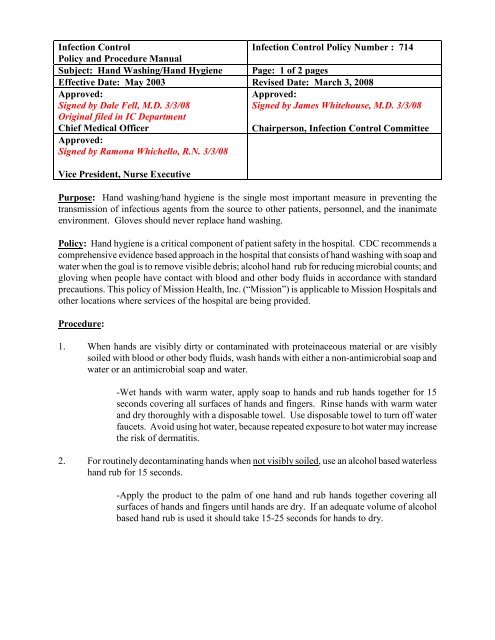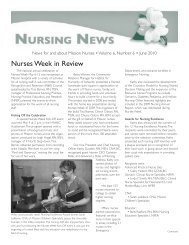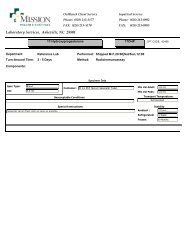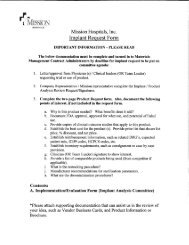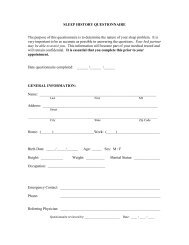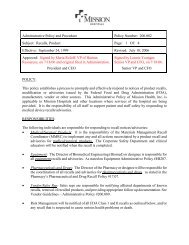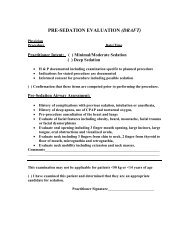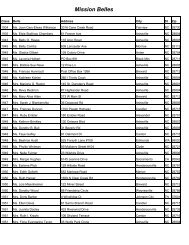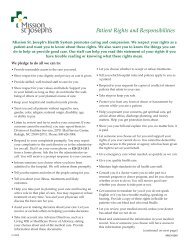Infection Control Policy and Procedure Manual ... - Mission Health
Infection Control Policy and Procedure Manual ... - Mission Health
Infection Control Policy and Procedure Manual ... - Mission Health
- No tags were found...
You also want an ePaper? Increase the reach of your titles
YUMPU automatically turns print PDFs into web optimized ePapers that Google loves.
<strong>Infection</strong> <strong>Control</strong><strong>Infection</strong> <strong>Control</strong> <strong>Policy</strong> Number : 714<strong>Policy</strong> <strong>and</strong> <strong>Procedure</strong> <strong>Manual</strong>Subject: H<strong>and</strong> Washing/H<strong>and</strong> Hygiene Page: 1 of 2 pagesEffective Date: May 2003 Revised Date: March 3, 2008Approved:Approved:Signed by Dale Fell, M.D. 3/3/08Signed by James Whitehouse, M.D. 3/3/08Original filed in IC DepartmentChief Medical OfficerChairperson, <strong>Infection</strong> <strong>Control</strong> CommitteeApproved:Signed by Ramona Whichello, R.N. 3/3/08Vice President, Nurse ExecutivePurpose: H<strong>and</strong> washing/h<strong>and</strong> hygiene is the single most important measure in preventing thetransmission of infectious agents from the source to other patients, personnel, <strong>and</strong> the inanimateenvironment. Gloves should never replace h<strong>and</strong> washing.<strong>Policy</strong>: H<strong>and</strong> hygiene is a critical component of patient safety in the hospital. CDC recommends acomprehensive evidence based approach in the hospital that consists of h<strong>and</strong> washing with soap <strong>and</strong>water when the goal is to remove visible debris; alcohol h<strong>and</strong> rub for reducing microbial counts; <strong>and</strong>gloving when people have contact with blood <strong>and</strong> other body fluids in accordance with st<strong>and</strong>ardprecautions. This policy of <strong>Mission</strong> <strong>Health</strong>, Inc. (“<strong>Mission</strong>”) is applicable to <strong>Mission</strong> Hospitals <strong>and</strong>other locations where services of the hospital are being provided.<strong>Procedure</strong>:1. When h<strong>and</strong>s are visibly dirty or contaminated with proteinaceous material or are visiblysoiled with blood or other body fluids, wash h<strong>and</strong>s with either a non-antimicrobial soap <strong>and</strong>water or an antimicrobial soap <strong>and</strong> water.-Wet h<strong>and</strong>s with warm water, apply soap to h<strong>and</strong>s <strong>and</strong> rub h<strong>and</strong>s together for 15seconds covering all surfaces of h<strong>and</strong>s <strong>and</strong> fingers. Rinse h<strong>and</strong>s with warm water<strong>and</strong> dry thoroughly with a disposable towel. Use disposable towel to turn off waterfaucets. Avoid using hot water, because repeated exposure to hot water may increasethe risk of dermatitis.2. For routinely decontaminating h<strong>and</strong>s when not visibly soiled, use an alcohol based waterlessh<strong>and</strong> rub for 15 seconds.-Apply the product to the palm of one h<strong>and</strong> <strong>and</strong> rub h<strong>and</strong>s together covering allsurfaces of h<strong>and</strong>s <strong>and</strong> fingers until h<strong>and</strong>s are dry. If an adequate volume of alcoholbased h<strong>and</strong> rub is used it should take 15-25 seconds for h<strong>and</strong>s to dry.
<strong>Infection</strong> <strong>Control</strong> <strong>Policy</strong> #714 – H<strong>and</strong> Washing/H<strong>and</strong> Hygiene 2-Decontaminate h<strong>and</strong>s not visibly soiled with alcohol h<strong>and</strong> rub or alternately with anantimicrobial soap <strong>and</strong> water:a. when entering a patient’s room,b. before donning sterile gloves wheninserting a central intravascular catheter,c. before inserting urinary catheter, peripheral vascular cathetersor other invasive device,d. after contact with patient’s intact skin (taking a pulse or blood pressure,or lifting a patient),e. after contact with body fluids or excretions, mucus membranes, nonintactskin or wound dressings as long as h<strong>and</strong>s not visibly soiled,f. if moving from a contaminated body site to clean site during patientcare,g. after contact with inanimate objects in immediate vicinity ofthe patient,h. after removing glovesi. when leaving a patient’s room.3. Wash h<strong>and</strong>s for 15 seconds with soap (non-antimicrobial or antimicrobial) <strong>and</strong> waterbefore eating <strong>and</strong> after using a restroom.4. Wash h<strong>and</strong>s with non-antimicrobial or antimicrobial soap <strong>and</strong> water if exposure toClostridium difficile, Norovirus or Bacillus anthracis is suspected or proven. Thephysical action of washing <strong>and</strong> rinsing h<strong>and</strong>s under such circumstances is recommendedbecause alcohols, chlorhexidine, iodophors, <strong>and</strong> other antiseptic agents have poor activityagainst spores <strong>and</strong> some viruses.5. Do not wear artificial fingernails or extenders (i.e. acrylic nails, tips, wraps made of silk,linen, fiberglass, gels, glues <strong>and</strong> mixture of these products) when having direct contactwith patients. Keep natural fingernail tips less than 1/4 inch long.6. Wear gloves when it can be reasonably anticipated that contact with blood or mucusmembranes, other potentially infectious material <strong>and</strong> non-intact skin will occur.7. Remove gloves after caring for a patient - do not wear the same pair of gloves for care ofmore than one patient, <strong>and</strong> do not wash gloves between patients. (H<strong>and</strong>s to be thoroughlydried before donning gloves.)8. Use hospital approved water based h<strong>and</strong> lotion in order to minimize h<strong>and</strong> irritation thatmay be associated with h<strong>and</strong> washing or h<strong>and</strong> antisepsis.9. When performing surgical procedure use either the specific alcohol based h<strong>and</strong> rub orantimicrobial soap for surgical h<strong>and</strong> antisepsis before donning sterile gloves. When usingan alcohol based h<strong>and</strong> rub, h<strong>and</strong>s <strong>and</strong> forearms are to be prewashed with a nonantimicrobialsoap <strong>and</strong> water <strong>and</strong> dried completely. Decontaminate h<strong>and</strong>s using a spongeto minimize skin damage. Refer to OR Department specific policies for details onsurgical h<strong>and</strong> scrub.


